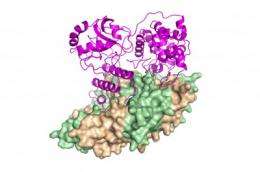New recruits in the fight against disease

(Medical Xpress) -- Scientists have discovered the structure and operating procedures of a powerful anti-bacterial killing machine that could become an alternative to antibiotics.
In research published in the Proceedings of the National Academy of Science USA, scientists from Monash University, The Rockefeller University and the University of Maryland detail how the bacteriophage lysin, PlyC, kills bacteria that cause infections from sore throats to pneumonia and streptococcal toxic shock syndrome.
Bacteriophages, viruses that specifically infect and kill bacteria using special proteins called lysins, have been investigated as possible treatments since 1919. However, with the discovery of antibiotics in the 1940s, 'phage therapy' was generally abandoned.
In collaboration with Professor Vince Fischetti at Rockefeller and Dr. Dan Nelson at Maryland, Monash researchers Professor James Whisstock, Associate Professor Ashley Buckle and Dr. Sheena McGowan from the School of Biomedical Sciences, have spent the last six years deciphering the atomic structure of PlyC, to better understand its remarkable anti-bacterial properties.
Dr. McGowan said PlyC looked a little like a spaceship.
"PlyC is actually made from nine separate protein ‘parts’ that assemble to form a very effective bacterial killing machine. It actually resembles a flying saucer carrying two warheads," Dr. McGowan said.
"It operates by locking onto the bacterial surface using eight separate docking sites located on one face of the saucer. The two warheads can then chew through the surface of the cell, rapidly killing the bacteria."
Associate Professor Buckle said the PlyC, which attacks the streptococci bacteria, was a very promising target for the future development of new drugs.
"PlyC, in its purified form, has been shown to be 100 times more efficient at killing certain bacteria than any other lysin to date – even faster than household bleach," Associate Professor Buckle said.
First identified in 1925, PlyC was purified in the 1960s by Professor Fischetti, but its atomic structure proved elusive until now.
"Scientists have been trying to decipher the structure of PlyC for more than 40 years. Finally knowing what it looks like, and how it attacks bacteria, is a huge step forward," Dr. McGowan said.















